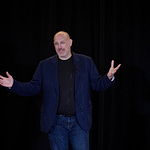What if the next leap in human health isn’t hidden in our genes, but in everything that happens to them? In this week’s truly groundbreaking Mendelspod episode, we open a new chapter for the show: our first deep dive into exposomics—the study of all the physical, chemical, biological, and social exposures that shape the human body across a lifetime.
To guide us, we welcomed two leaders at the center of this emerging field: Chirag Patel of Harvard and Gary Miller of Columbia University, fresh off organizing Genomics Meets Exposomics, a landmark meeting held at the Mendel Museum in Brno—the birthplace of modern genetics. In the same abbey where Mendel tended pea plants, genomics and exposomics researchers from Europe and the U.S. gathered for the first time to build a shared roadmap for understanding how genes and environment interact to drive disease.
In our conversation, Chirag and Gary explain why the genome alone can’t answer the biggest questions in human health. While genomics accounts for roughly 20% of complex disease risk, the remaining 80% lies in our exposures—pollutants, diet, geography, stress, microbes, medications, and more—and the fingerprints these exposures leave on our biology. Exposomics, as Gary notes, is about moving from studying one factor at a time to systematically measuring the thousands of signals that accumulate in our tissues and blood.
A major theme of the discussion—and the inspiration for our episode title—is Chirag Patel’s call for exposomics to follow the same playbook that transformed genomics in the early 2000s. Just as genome-wide association studies (GWAS) revolutionized how we identify genetic contributors to disease by moving beyond one-gene-at-a-time thinking, Patel argues that the field now needs exposome-wide association studies (EWAS) to systematically search for environmental drivers. “If we are to do an exposome-wide association study… we can now discover things that were missing,” he explains, shifting from narrow, candidate-factor approaches to broad, data-driven discovery.
Both guests describe a field gaining momentum thanks to better measurement technologies, large biobanks, geospatial data, and new analytic frameworks inspired by genome-wide association studies. They also speak frankly about the remaining hurdles. As Chirag puts it, one of the major challenges is not just correlating exposures with disease but determining what these findings mean for people: “There’s a number of questions that come after that…how do you modify it? Is it causal? How do we remove it from the population if it’s adverse?”
Gary, who has spent decades studying Parkinson’s and Alzheimer’s, explains how high-resolution mass spectrometry now allows researchers to see exposure signals that were invisible before—sometimes even in decades-old blood samples. And looking ahead, he offers a clear note of optimism about exposomics’ readiness for scale: “We can do this now. It’s a reality.”
For long-time Mendelspod listeners, the episode marks an inflection point. After fifteen years covering genomics and the multi-omic revolution, this conversation shines a light on the other half of human biology—the environment—and what may become the next major frontier in disease prevention, drug development, and precision health.










